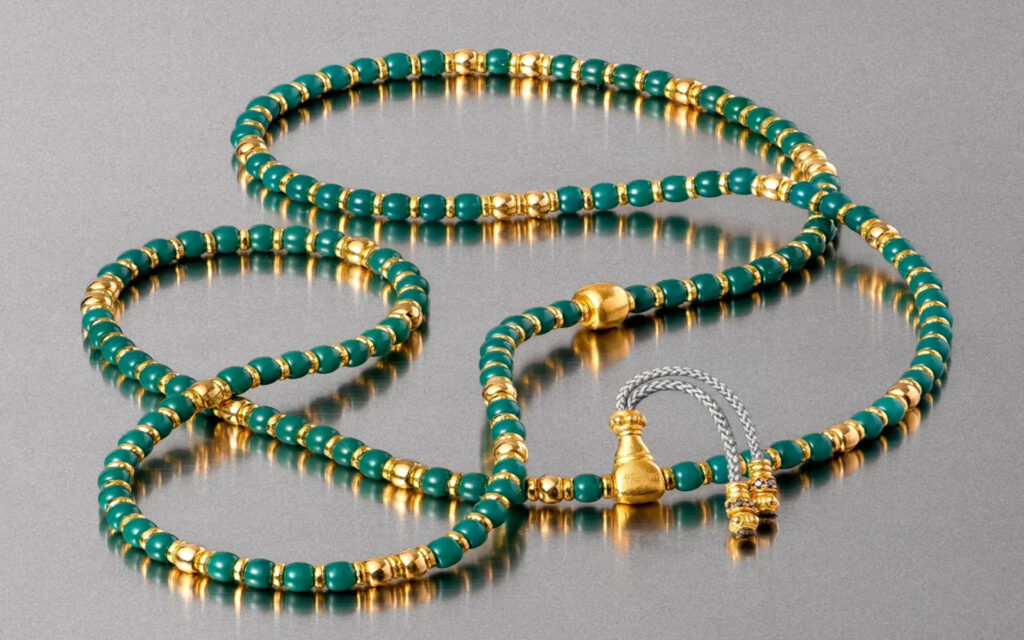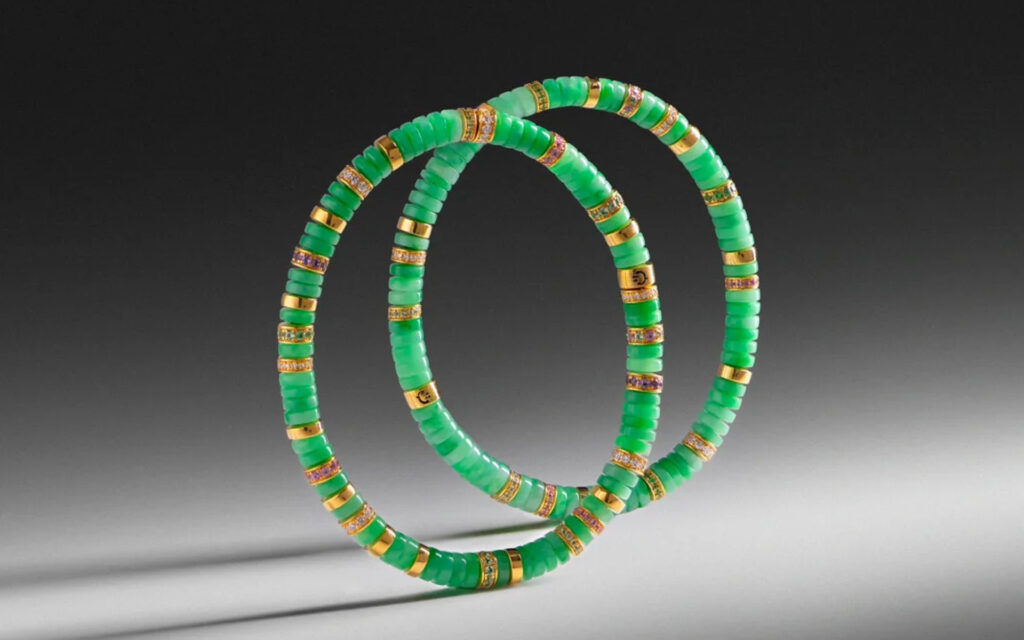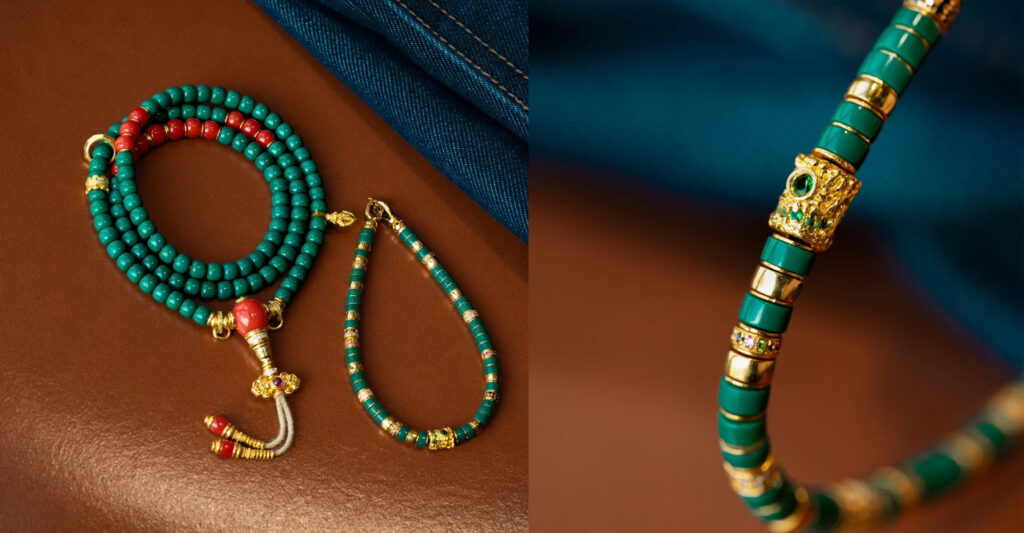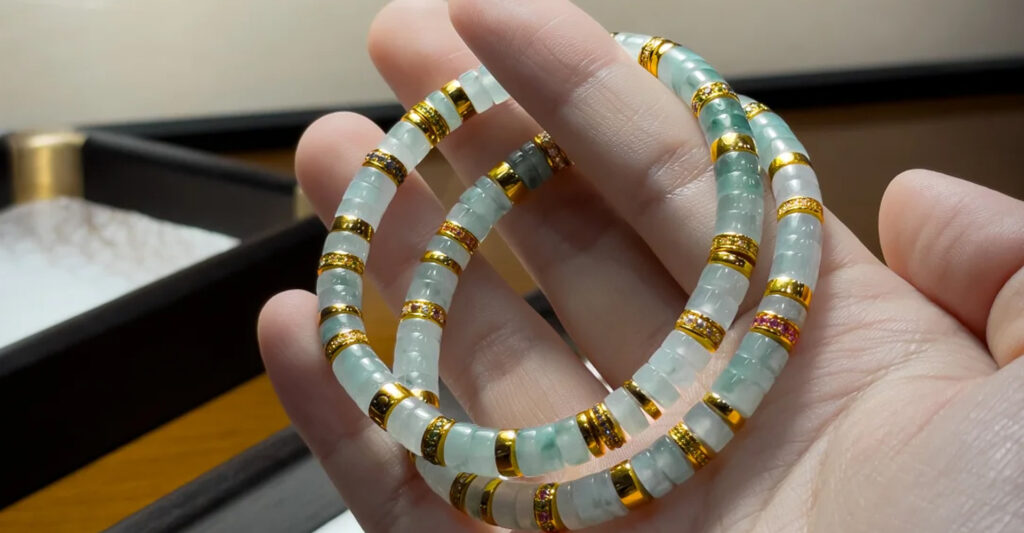Bracelets, also known as prayer beads or Buddhist beads, are believed in Buddhism to eliminate karmic obstacles and symbolize a vision of goodness. Today, many view bracelets as fashionable accessories, while others recognize their collectible value and potential for appreciation. Mastering how to pair bracelets for different individuals and materials—whether for better aesthetics or elevated sophistication—is indeed an art. Generally, coordinating a Buddhist bead bracelet involves considering three key aspects: hardness, structure, and color.

I. Guiding Principles:
Matching Similar Hardness, Incorporating Spacer Beads
When selecting beads for a bracelet, it’s crucial to consider their hardness. If beads with significantly different hardness levels are used, the harder beads should not have pronounced edges to prevent wear on the softer ones. If the hardness difference between the beads and the main beads is too great, consider replacing the beads with ones of similar hardness or using spacers like coconut shell to separate them, providing added protection.
Nanhong, with its relatively high hardness and unparalleled vibrant red hue, makes an excellent choice for accent beads. Many prefer Nanhong beads in bracelets, while pairing with Baoshan material often conveys a sense of higher quality—especially Baoshan pumpkin beads, which exude an elegant simplicity. For Buddhist bead bracelets like Star Moon Bodhi, Vajra Bodhi, or Bodhi Root, South Red serves as an ideal accent—neither overshadowing the main beads nor overpowering them, while also being highly enjoyable to handle.
For those who favor blue accent beads, lapis lazuli is undoubtedly the best choice. Its sufficient hardness makes it resistant to wear, and it excels at highlighting individuality in bracelet combinations. Some lighter-colored bracelets, like those made from Bodhi root or turban shell, become strikingly eye-catching when paired with lapis lazuli accents—a style favored by many. When using lapis lazuli as an accent bead, it’s often combined with turquoise or nanhong for a complementary effect.
Malachite is now increasingly crafted into various accent beads for sale. Its inherent resemblance to the speckled green feathers of a peacock is highly appealing, and its unique patterns make it popular not only in ornaments and pendants but also as accent beads. It boasts a greener hue than turquoise and features ever-changing, intricate patterns. However, malachite has relatively low hardness, making it best paired with softer wooden bracelets. If pairing with harder materials like jade or coral, use sterling silver or coconut shell spacers to separate them.

II. Principles to Follow
Uniform Form, Innovative Design
To create an aesthetically pleasing bead strand, selection and balance are crucial. Simply piling on expensive beads won’t guarantee beauty; cohesion is key. The upper and lower sections of the mala should share a unified style, with structural and form elements that resonate. Uniformity in form means: drum beads with drum beads, round beads with round beads. Mixing drum and round beads not only fails to enhance decoration but creates jarring, mismatched looks. Additionally, inconsistent spacing between beads disrupts visual harmony.
Gradual size variation refers to the size progression between bodhi seeds and accessories, as well as between adjacent accessories—either gradually increasing or decreasing. Symmetry, rooted in China’s millennia-old aesthetic tradition and compositional principles, applies to the spacer beads flanking each bead. Beads on either side that share the same size, material, and function should ideally be identical in both form and proportion. Of course, bead specifications aren’t uniform; they feature diverse styling variations distinguished by different spacer beads. Taking the 108-bead rosary as an example, let’s discuss bead arrangement.
When worn purely as bracelets, neither the Buddha head (the large bead at the knot point, typically the triple-hole bead) nor the spacer beads (large beads of contrasting material threaded every 27 beads among the 108 beads, called “knot beads,” “divider beads,” or “spacer beads”) adhere to traditional Buddhist bead requirements. Their forms are entirely customizable. One consistent element is that spacer beads are always crafted from beads of different colors. Stylistically, spacer beads fall into four main categories: no spacer beads, one type of spacer bead, two types of spacer beads, or multiple types (three or more).
Strictly speaking, a Buddhist rosary must have three Buddha heads; without them, it cannot be called a rosary. However, for bracelets worn on the wrist, Buddha heads are optional. Separator beads have no fixed pairing—they should simply be pleasing to the eye. Within a single bracelet design, the main beads must be identical in shape, while separator beads can vary in form—be they round, barrel-shaped, melon-shaped, etc. As mentioned, one function of spacer beads is to prevent monotony in the bracelet. Varied shapes enhance flexibility and prevent a stiff appearance.

III. Guiding Principle
Harmonious Tones, Artful Contrasts
Buddhist beads are typically paired using two contrasting colors, two shades with significant brightness differences, or near-contrasting hues. This combination creates a striking visual impact where each element enhances the other. Most enthusiasts prefer arranging bead strands in Tibetan-style rosary or court bead configurations. Primary hues thus fall into three categories: red, yellow, and green. Complementary colors typically include white, purple, silver, etc. First select three base tones, then incorporate accent colors according to personal preference.
In both Tibetan Buddhism and traditional Chinese culture, there’s a shared appreciation for bold, vibrant hues. Thus, clashing colors create the most dazzling effect—cool tones paired with warm, monochromatic with multicolored. For instance, green and red make an excellent combination, while coral and nanhong jade clash abruptly. Turquoise and other green beads paired solely with silver jewelry may not always look their best. If you prefer a more flamboyant style, such combinations are perfectly suited. Showcasing the charm of different materials within a primary color scheme is also a brilliant creative approach.
Impactful colors create a refreshing sensation and accentuate an extraordinary aura. Such pairings typically feature a dominant hue—like pure white or pure red—needing a contrasting color to break monotony. The contrast needn’t be stark: egg yolk paired with white, or pink paired with red. Those who favor elegant, fresh styles should try this approach.
Within simplicity, it’s crucial to convey tranquility without appearing dull or tacky. A well-placed accent color achieves this effect. This pairing typically combines different materials within the same color family. Depending on the shades chosen, the overall look can appear serene, mysterious, or pristine. Examples include pairing olive wood with amber, camel bone with bodhi root, or turquoise with lapis lazuli. Those with a preference for a particular hue can embrace this approach.

For enthusiasts of multi-gemstone bracelets, eclectic mixing is the perfect choice. However, careful consideration of color combinations is essential, as some pairings may yield unsatisfactory results. Introducing an intervening color can transform the effect entirely. This style requires establishing a dominant color and selecting a secondary shade to complement it. For instance: Bodhi seeds with lapis lazuli tri-beads, olive pits with ivory fruit tri-beads, or turban shell with South Red tri-beads. When featuring a dominant bead, consider the accent style. Since the main bead typically boasts superior material and appealing color, complementary hues enhance its visual impact.
It’s important to note that regardless of your choices, color harmony is essential. For instance: Star Moon beads are generally white or pale yellow, turning light brown with age, so transition colors should primarily be selected from these shades. Transition colors are typically used for the Buddha head, both sides of the top bead, and pendants. Accent colors are for elements like the pendant below the Buddha head, allowing for flexible adjustment. Certain colors clash with Star Moon beads, creating a jarring effect. Avoid pairing them with overly dark South Red jade, using lapis lazuli as spacers without transitional beads, or flanking each bead with black coconut shell spacers—these combinations appear too abrupt. If such colors must be incorporated, insert transitional spacers on either side of these bold elements.